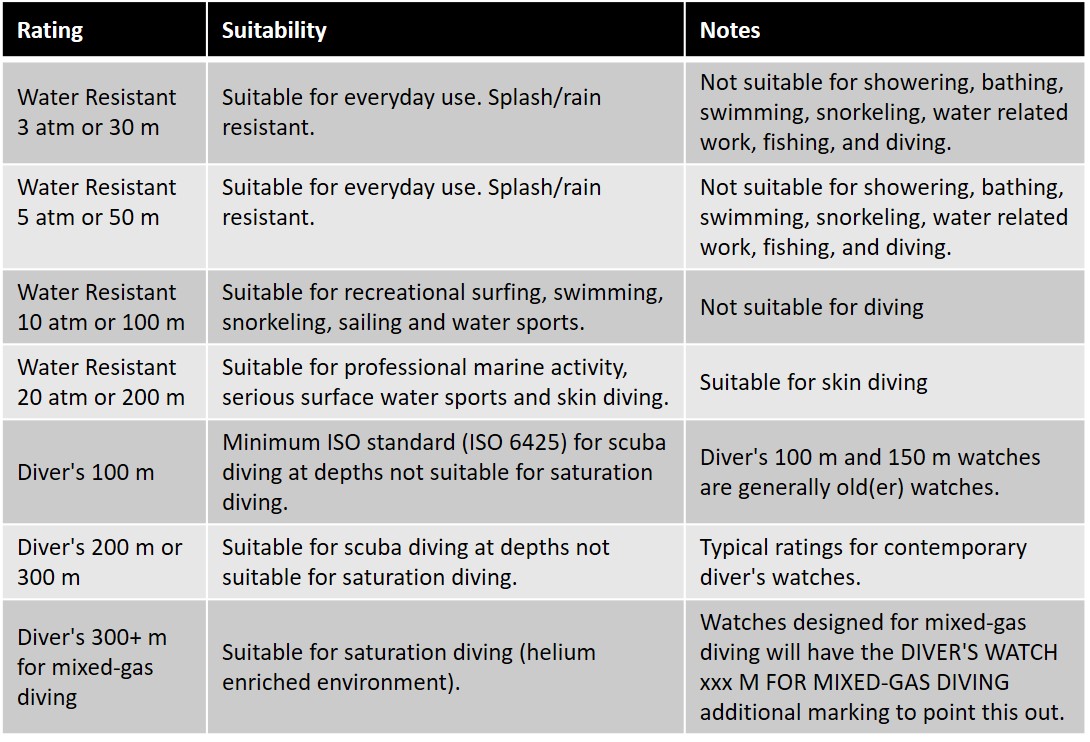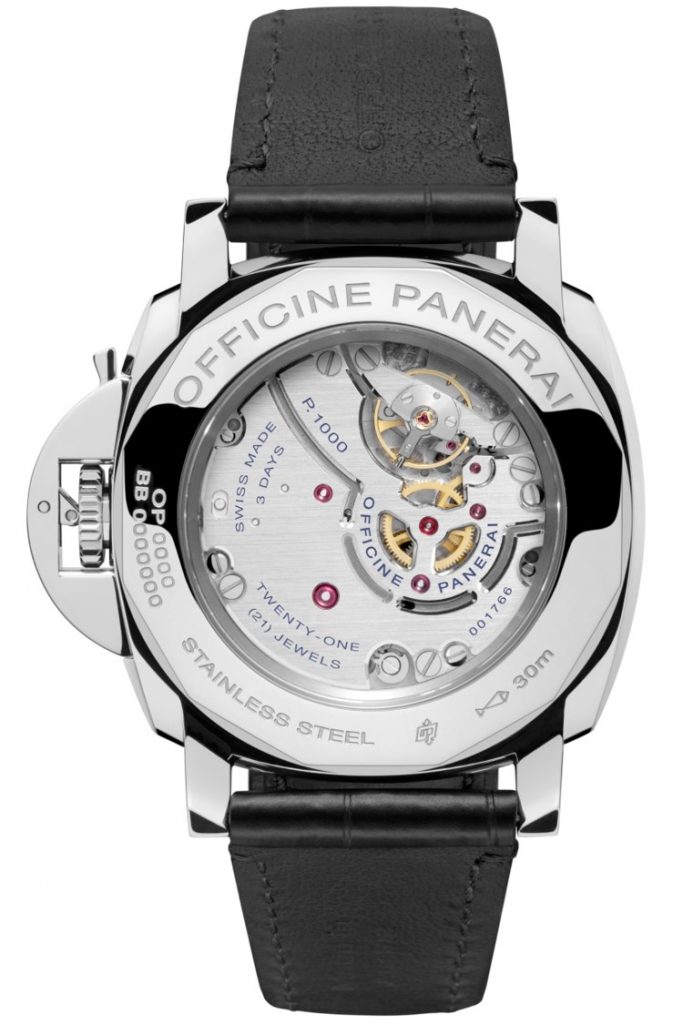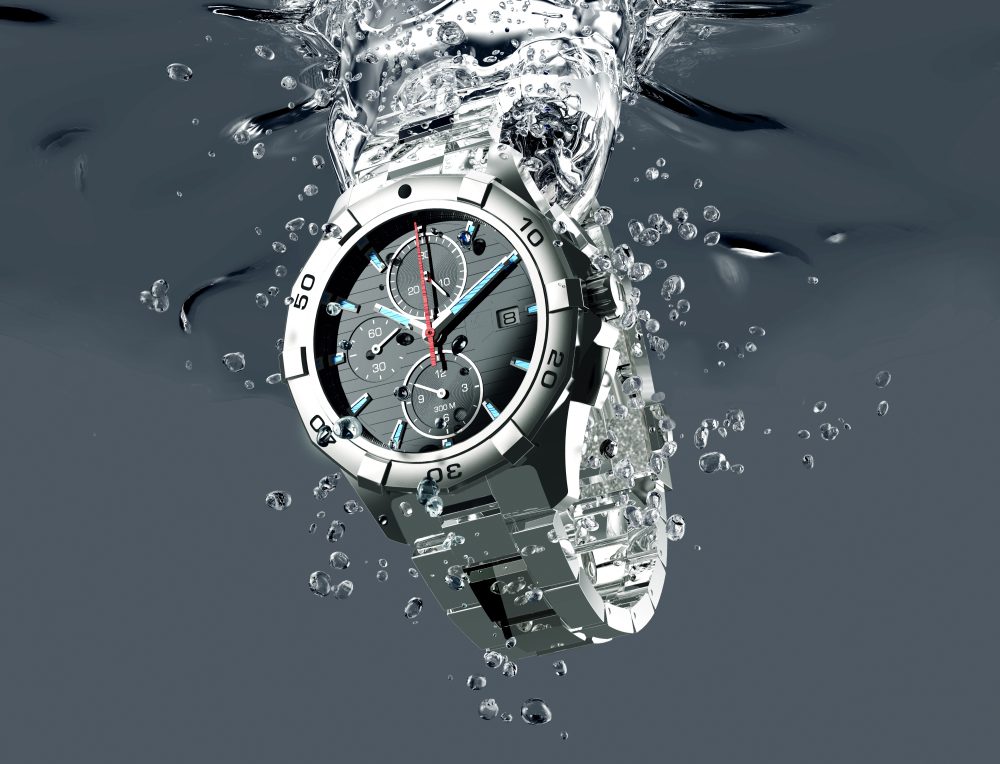So you’ve gone out and bought yourself a new watch and after having looked at the water resistance rating declared by the manufacturer you’re confident that it will stand up to the daily lifestyle that you’re accustomed to. However after having worn it in relatively light situations, you’ve now noticed that the watch is showing signs of water inside the case. Surely this cant be right?! Well, depending on the rating you could be in for a nasty surprise.
There are in fact two international standards for the water resistance of watches. These are ISO 22810:2010 and ISO 6425. ISO 22810:2010 (which as the designation implies was revised in 2010) defines the standard by which watches are tested and denotes the applied markings allowed to be placed on the watch.
The table below is an extract of ratings and their suitability for proximity or use in water (also available at https://en.wikipedia.org/wiki/Water_Resistant_mark)

You will note from the table that watches carrying a water resistance rating of 30m or 50m both state they are “Not suitable for showering, bathing, swimming, snorkeling, water related work, fishing, and diving.”
In our research we did find a number of websites, forums and watch manufacturers with differing views and opinions on the suitability of watches rated to 50m (or 5atm) with some stating that 50m should be fine for use while swimming, and others stating that a watch with a rating of 50m must not be subjected to more than a few “splashes”. While writing this article we actually have a watch lent to us by Stowa which has “Waterproof 5 atm” inscribed on the back. However in the guarantee booklet it clearly states “…removing the watch before bathing” – which is not exactly confidence inspiring from the manufacturer as it might as well say “For warrantly purposes, don’t get this watch wet”
The Pro’s…
ISO 6425 on the other hand is a completely different affair. As you can see from the table above, the minimum depth possible in order to attain ISO 6425 is 100m (from the older standard) and nowadays 200m is the minimum to attain ‘6425. Although there are a lot of additional requirements that a watch must meet in order to qualify (such as readability and resistance to magnetism) there are two significant differences with regards to water resistance.
Firstly the watch must be tested to 125% of the stated rating. So for a watch with a water resistance of 200m, it will be tested to a depth pressure rating of 250m. Secondly and most importantly every single watch must be tested. Not a sample but 100% of watches produced must be tested. Once all the test are satisfactorily passed, the watch may carry the designation “Divers”. Interestingly this is why there are a number of different Seamasters in Omega’s range with one called “Divers 300m” as this model conforms to the ISO6425 standard and all watches have been tested. Interestingly there are some great value watches that meet this standard and in fact the rather legendary Seiko SKX is one of them as you will see on the dial it bears the marking “Divers 200” – this alone makes the SKX incredible value for money.
One other notable factor is that sudden changes in heat can also adversely affect the seals in a watch. Therefore plunging into cold water or indeed a hot bath or hot tub could also compromise the seal of your watch allowing water to enter and potentially causing major damage.
As there is so much ambiguity as to the suitability of wearing a watch anywhere near water with a rating of less than 100m we would recommend that for the sake of preserving your watch you either remove it at the mere prospect of going near water or only buy watches that have at least 100m water resistance. However that leads us on to one last point…….
 Panerai have produced almost exclusively divers watches for over 80 years (since 1938) ranging back to the Italian navy in world war II. First their Radiomir range of divers watches and then later their Luminor range of divers watches which contain patented crown locks. However their latest watch is nothing short of a lesson in irony. Allow me to introduce you to the Panerai Luminor ‘Due’. This watch as part of their Luminor range includes their iconic crown guard specifically designed to protect it in the event it comes into contact with an object underwater. So I hear you ask, what’s wrong with that? Well the watch has a water resistance rating of 30m! Yep that’s right Panerai have produced a divers watch that cannot go near water!
Panerai have produced almost exclusively divers watches for over 80 years (since 1938) ranging back to the Italian navy in world war II. First their Radiomir range of divers watches and then later their Luminor range of divers watches which contain patented crown locks. However their latest watch is nothing short of a lesson in irony. Allow me to introduce you to the Panerai Luminor ‘Due’. This watch as part of their Luminor range includes their iconic crown guard specifically designed to protect it in the event it comes into contact with an object underwater. So I hear you ask, what’s wrong with that? Well the watch has a water resistance rating of 30m! Yep that’s right Panerai have produced a divers watch that cannot go near water!
So which would you choose – a Panerai Divers watch that can’t go near water for £5100 or a Seiko SKX ISO certified Divers watch for less than £200?
Whats your experience of water resistance ratings? – let us know in the comments.


5 Comments
Another great article Ben 👌
The rating is only as good as the watches gaskets and sealing surfaces. A 20 year old 200m divers watch came to me recently after flooding. The seals were reasonably good but a sealing surface ( the inside of the case back) was pitted causing a bad seal. This was 316 stainless but had obviously lived all it’s life in a very humid environment.
I think that’s an excellent point! All too often people expect a watch to perform as well as it did the day it was purchased and while the rubber seals can be replaced, it’s a whole other story if the the metal surface has become compromised. This is why it’s really important to get the seals checked periodically.
Aged 13 I would swim ~2.5m down to the bottom of every swimming pool wearing my casio W-59B quartz watch (50m rated).
I used the stopwatch underwater to time how long I could stay down there.
It never failed and that was despite me using the stopwatch and light many times over 2 years at the bottom of different pools (on different vacations) and showering with it still on daily.
Hi John
The water resistance stated on the watch is the maximum that the manufacturer can be held accountable for which means if it does fail they will only cover it under warranty if it has been used within the ISO rating declared by the manufacturer (ISO22810 and ISO6425). However this doesn’t stop the watch being built better than declared and Casio are one manufacturer who regularly exceed build better than they say. However if the water resistance of any watch fails it will only be covered by how the manufacturer ‘warrants’ the watch by its design.